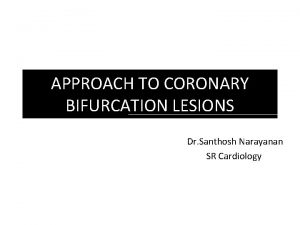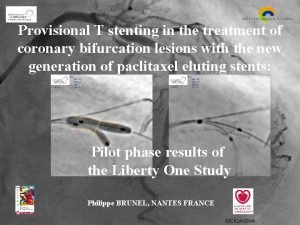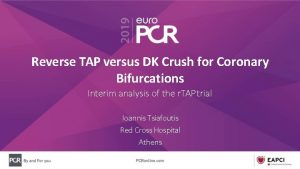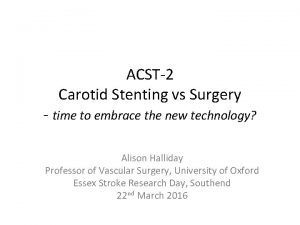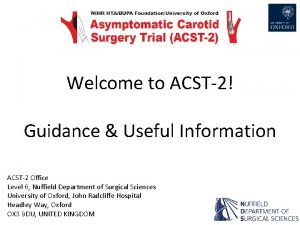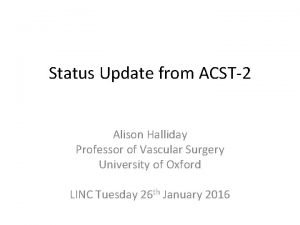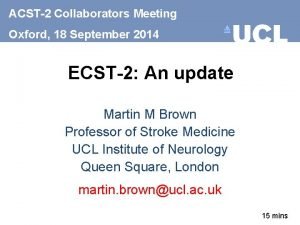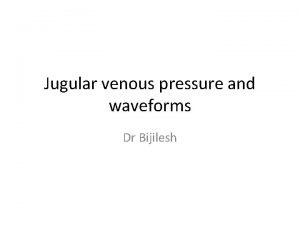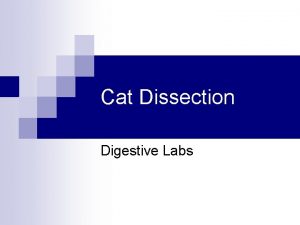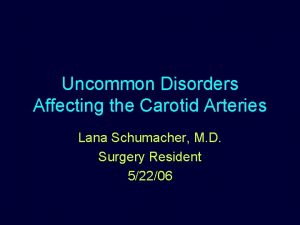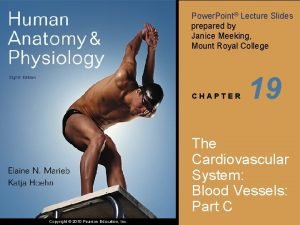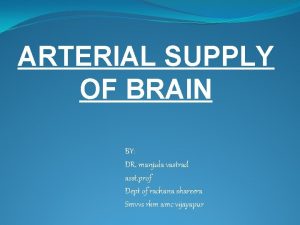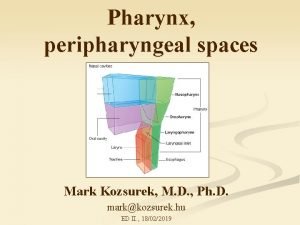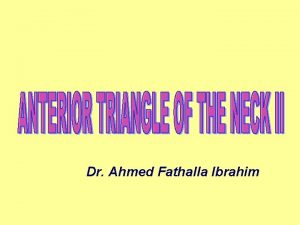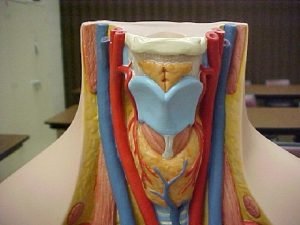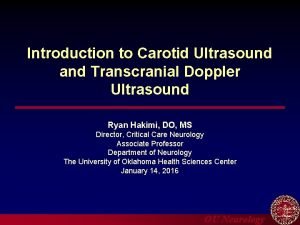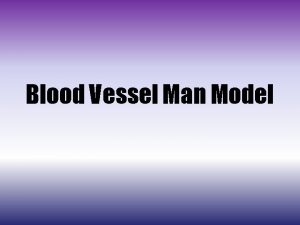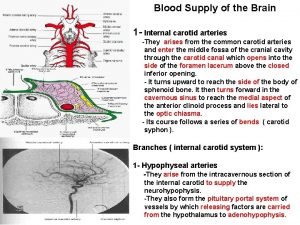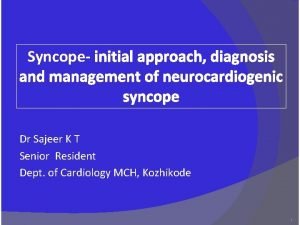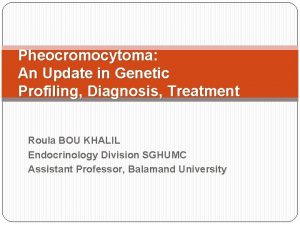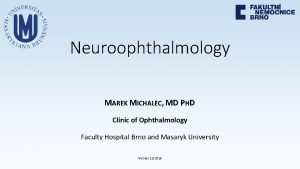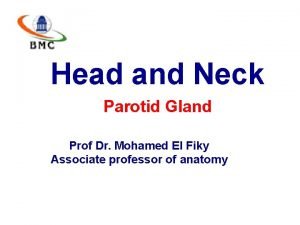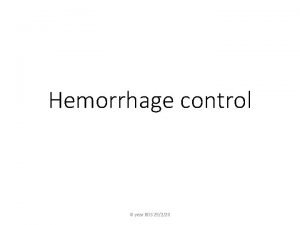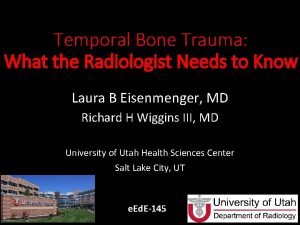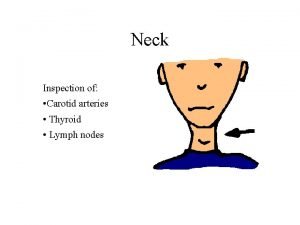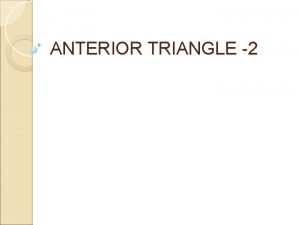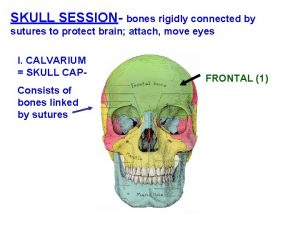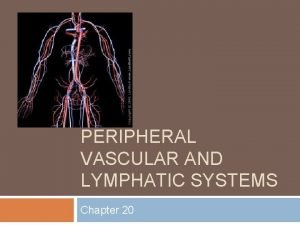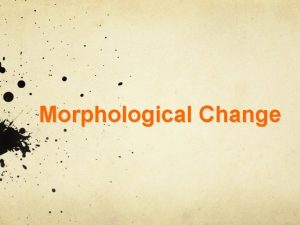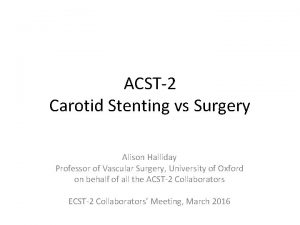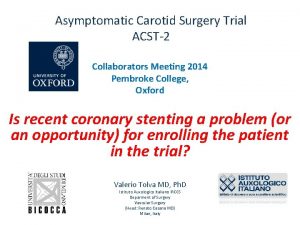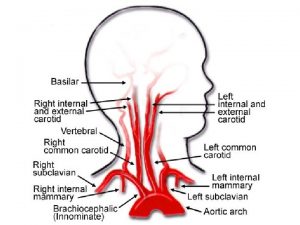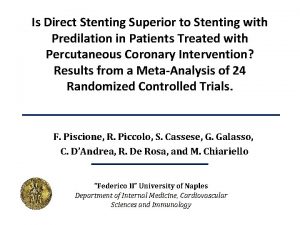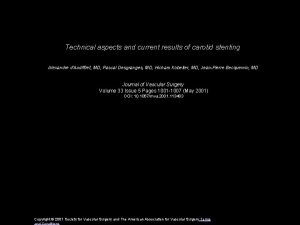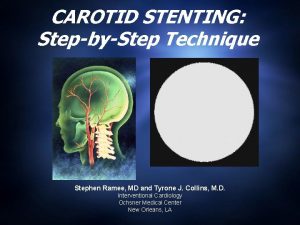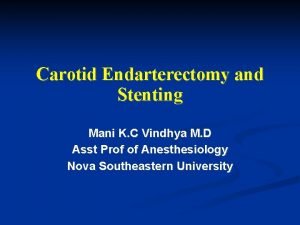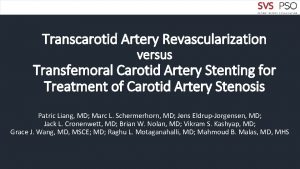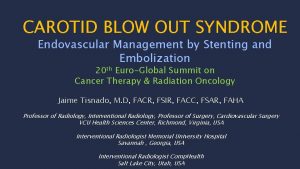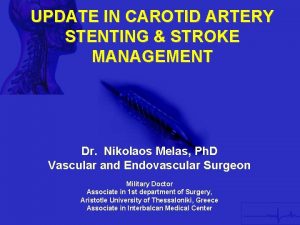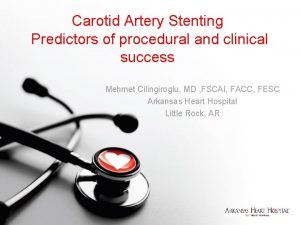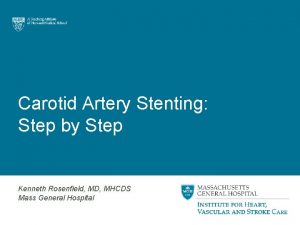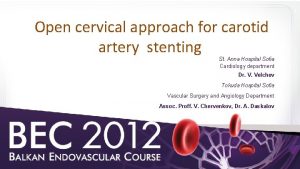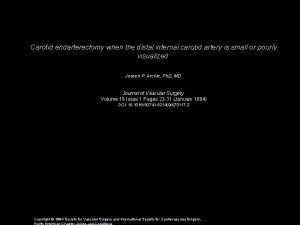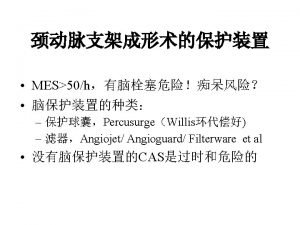ACST2 Carotid Stenting vs Surgery Alison Halliday Professor































- Slides: 31

ACST-2 Carotid Stenting vs Surgery Alison Halliday Professor of Vascular Surgery, University of Oxford on behalf of all the ACST-2 Collaborators ECST-2 Collaborators’ Meeting, March 2016

Asymptomatic carotid artery stenosis: narrowing that has not yet caused a stroke Might intervention prevent stroke?

ACST-1 3120 patients, severe stenosis eligible for CEA randomized to: Immediate CEA vs ‘control’ (no CEA unless symptoms occur)

‘Asymptomatic’ - a misnomer? 41% ACST-1 patients had h/o stroke-type symptoms or CT brain infarcts, they were at higher stroke risk ~ 3% yr

ACST-1: CEA reduces 10 -year stroke risk by 6 -7%

Statins – lower overall stroke risk, but CEA provides additional 6% absolute benefit

In ACST-1 – peri-operative risk is reduced by statin therapy ACST-1 4. 3% 2. 2%

Since ACST-1: Falling risks from CEA and CAS • Reduced procedural risk for CEA (Statins) • Reduced procedural risks for CAS…

Falling risks from CEA and CAS • Reduced procedural risk for CEA (Statins) • Reduced procedural risks for CAS…

Techniques, devices, experience have all changed since the earlier symptomatic trials… Open vs closed-cell stent design Closed–cell safer? Now – have FLOW-reversal systems, direct puncture, membrane stents. . reduces risk of distal embolisation

Open and closed-cell stents


Wallstent closed-cell

Cristallo Ideale (Hybrid) Open Cell Stent with Closed Cell Design Proximal and distal sections – open cell, enhanced flexibility Central closed cell section

Membrane Stent Roadsaver


Mo. Ma Flow-reversal catheter

Roadsaver/Silk Road – avoids aortic arch, controlled flow reversal

Treatment for asymptomatic carotid artery stenosis: surgery or stenting? Randomise patients considered to be at high future stroke risk, suitable for both procedures

ACST-2 A very European Trial

UK Centres in ACST-2

2015 Recruitment 14/62 randomising centres from UK Overall, 17% ACST-2 patients are from UK

ACST-2 Recruitment March 2016 2116 today

ACST-2 Sex, Age, Co-morbidities: Men Median age Ischaemic heart disease Diabetic Renal impairment 70% 69 years 37% 30% 9%

ACST-2 Stroke risk factors: Atrial Fibrillation Age >75 yrs Previous stroke symptoms or infarct Medical Treatments at entry: BP drugs Lipid-lowering Anti-thrombotic 6% 26% 43% 84% 80% 86% • good compliance with drug therapy after joining • direct patient feedback every year (includes drug names and doses)

Drug therapy at 1 month follow up (2015) Antithrombotic (aspirin, asasantin, clopidogrel, single, dual APT, warfarin, NOAC) 99. 5% BP Medications (1 -3 named drugs, none) 87% Lipid-lowering (specific drugs/doses) 88%

Drug therapy at Annual follow up (2015) Antithrombotic (aspirin, asasantin, clopidogrel, single, dual APT, warfarin, NOAC) 95% BP Medications (1 -3 named drugs, none) 83% Lipid-lowering (specific drugs/doses) 84%

ACST-2 Stents Cerebral Protection Devices (86%) Wallstent Emboshield Filter Cristallo Ideale Abbott Xact Filterwire Filter Mo. Ma Spider Accunet Angio. Guard Prox occ Filter Gore Flow Reversal Prox occ Vi. VEXX Twin One Distal balloon Roadsaver Inspire Zilver, Mer Fiber. Net Viatrac Filter Cordis Precise Ev 3 Protégé® RX Abbott Acculink Boston Adapt Sinus Wirion

ACST-2 Stents Wallstent (1. 08 mm 2) Xact (2. 54 mm 2) Boston Adapt (4. 4 mm 2) Precise (5. 89 mm 2) Vi. VEXX (closed, ? mm 2) Protégé® RX (10. 71 mm 2) Acculink (11. 48 mm 2) Cristallo Ideale (Hybrid) Sinus (Hybrid) Roadsaver (membrane) Inspire (membrane) Zilver, Mer Protection Devices Type Emboshield Filterwire Accunet Angio. Guard Spider Fibernet Viatrac Filter Mo. Ma Prox occ Gore Flow Reversal Prox occ Twin One Distal balloon Filter

ACST-2: Blinded Procedural hazards 1500 patients (≤ 30 days) Disabling/fatal stroke or fatal MI much lower than in symptomatic trials Despite increasing age and risk factors for stroke, interventional hazards in ACST-2 are lower than ACST-1: ACST-1 ACST-2 (CEA) (CEA and CAS) ‘blinded’ 1. 7% 1. 0% 30

NICE(2011) recommend randomisation in ACST-2 • UK Stroke and International Guidelines use this evidence – large vascular trials (many patients, long follow up) • Randomised Trials need to be large…… and work together to answer clinically important questions (who needs intervention, which intervention, how effective are statins for tight carotid stenosis, how low a BP is safe…) • ACST-2 is successfully enrolling patients, many have higher stroke risk because of previous symptoms and cerebral infarcts; this trial with others can help answer important questions ECST-2, ACT 1, CREST 2, SPACE 2…. . modern trials, working together to provide the evidence
 Mini culotte stenting
Mini culotte stenting Inverted provisional stenting
Inverted provisional stenting Tap bifurcation technique
Tap bifurcation technique Acst2 lancet
Acst2 lancet Acst2 trial
Acst2 trial Acst2 trial
Acst2 trial Acst2 lancet
Acst2 lancet Promotion from associate professor to professor
Promotion from associate professor to professor Jvp normal
Jvp normal Cricoid cartilage
Cricoid cartilage Combat lifesaver powerpoint
Combat lifesaver powerpoint Dr. lana schumacher
Dr. lana schumacher Posterior auricular vein
Posterior auricular vein Internal carotid artery
Internal carotid artery Lingual tonsil
Lingual tonsil Carotid triangle contents
Carotid triangle contents Sclaneus
Sclaneus Duplex ultrasound vs doppler
Duplex ultrasound vs doppler Interior trunk
Interior trunk Hippocampus blood supply
Hippocampus blood supply Carotid sinus hypersensitivity
Carotid sinus hypersensitivity Pheocromocytoma
Pheocromocytoma Carotid cavernous fistula
Carotid cavernous fistula Tympanic branch of glossopharyngeal nerve
Tympanic branch of glossopharyngeal nerve Parotid gland fascia
Parotid gland fascia Inferior defintion
Inferior defintion Carotid cochlear dehiscence
Carotid cochlear dehiscence Swollen cervical lymph nodes
Swollen cervical lymph nodes Boundaries of anterior triangle
Boundaries of anterior triangle Infraorbital foramen
Infraorbital foramen Carotid artery pulse
Carotid artery pulse Carotid cana
Carotid cana
